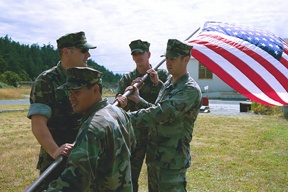U.S. Navy Sea Bees from Whidbey Island Naval Air Station will re-enact the planting of the U.S. flag at Iwo Jima during World War II that was made famous by a photograph.
Six Sea Bees from Construction Battalion Unit 417 stationed at the Seaplane Base will strike a pose reminiscent of the one made by five Marines and one Navy corpsman for an instant nearly 60 years ago.
The flag-raising will take place just prior to the fireworks display at City Beach Park on the 4th of July, at about 9:45 p.m., and is part of the city’s pyrotechnic production. The Sea Bees will don full combat gear and will slowly raise the flag, orchestrated to music and lighting.
The Sea Bees are honored that they were chosen for the production.
“Every time you see the American flag…it stands for one thing. It’s our home. It’s pride,” said U.S. Navy Chief Petty Officer Daniel Wisner, operations chief for CBU 417 and the coordinator of the Sea Bees for the event.
The raising of the flag has symbolic meaning for Wisner.
“It’s not just giving our (military) service. But, we’ll show everyone that we have pride in what we do,” he said.
Wisner quickly added that the Sea Bees will not attempt to duplicate the exact pose as seen in the historic photograph, so as to not diminish the importance of the original event.
Once the idea was presented to the Sea Bees, word spread throughout the 38-member command until everyone wanted to volunteer to take part in the production, said Warrant Officer Gregory Townsend, the officer in charge of CBU 417. A couple of early birds (or rather, Bees) volunteered immediately and secured their spots among the total group of six.
“I volunteered once it came up,” said Petty Officer 1st Class Craig Thomas.
At first Thomas didn’t know that the plan was to have all six in the flag-raising come from the Sea Bees command.
“One Navy person did the original one,” Thomas said. “I wanted to make sure a Sea Bee got in there.”
Petty Officer 2nd Class Brad Miller also secured a spot early on. He really wanted to take part because it is a good way to express his patriotism.
“I just wanted to show a little pride to the Sea Bees and to the Navy in general,” Miller said.
After the command asked for volunteers, which generated the overwhelming response, the chiefs of CBU 417 had to begin a selection process to narrow the group down to the six people needed for the event. Selections were made from those in the command, including the early volunteers, that have “sustained superior performance” and leadership skills, Townsend said.
Although most of the original flag planters on Iwo Jima were Marines, the Sea Bees here think they are a logical and appropriate choice to perform the reenactment.
Sea Bees are often the first U.S. military personnel in a combat zone, Townsend explained. Sea Bees go in to construct runways, build camps, roads, bridges and whatever is necessary to support military operations in any particular area.
Sea Bees provide construction work at Navy bases and they build and provide public works support to fleet hospitals during wartime. In their 58-year history, Sea Bees having been standing at the ready, able to deploy anywhere in the world within 48 hours.
In peacetime and at home in their shore-duty commands, Sea Bees also render humanitarian and natural disaster aid to communities.
All of the Sea Bees’ work seems to fit in with the Sea Bee motto: “With compassion for others, we build — we fight — for peace with freedom.”
The flag raisers
The six Sea Bees from Construction Battalion Unit 417 at Whidbey Island Naval Air Station who will participate in the reenactment of the World War II planting of the American flag at on Iwo Jima are:
Petty Officer 1st Class Craig Thomas
Petty Officer 2nd Class Brad Miller
Petty Officer1st Class Ceasar Canonizado
Petty Officer 1st Class Timothy Haukoos
Petty Officer 2nd Class Jason Trapasso
Petty Officer 3rd Class Jeremy Lipetzky
You can reach News-Times reporter Christine Smith at csmith@whidbeynewstimes.com or call 675-6611



